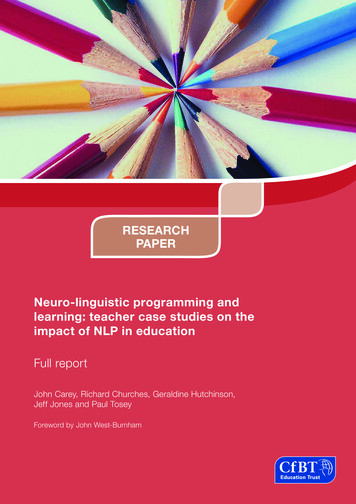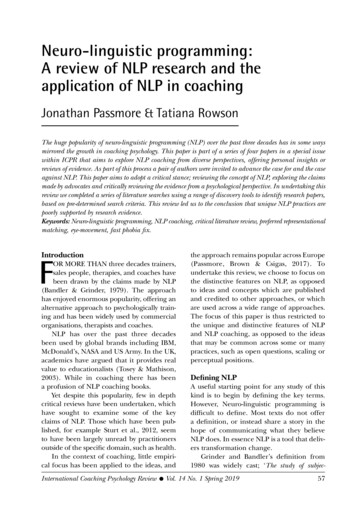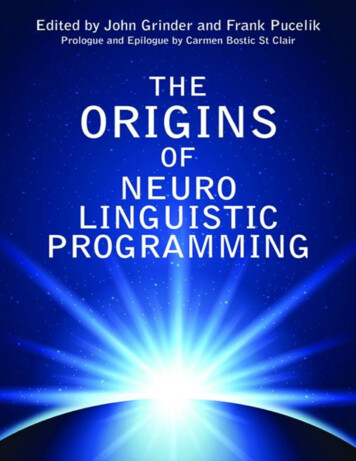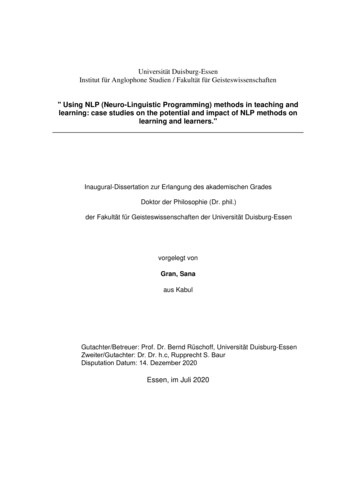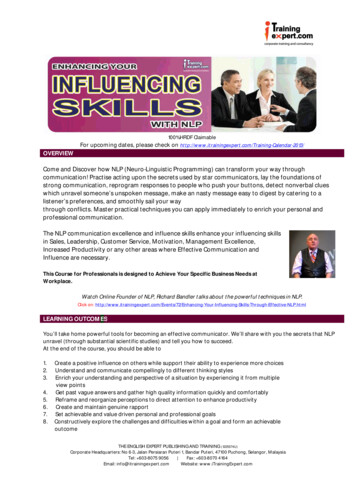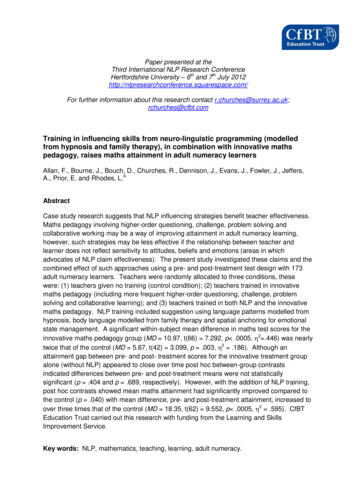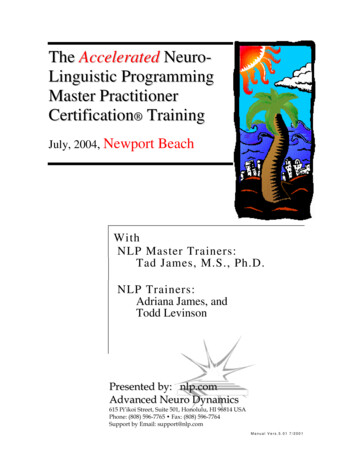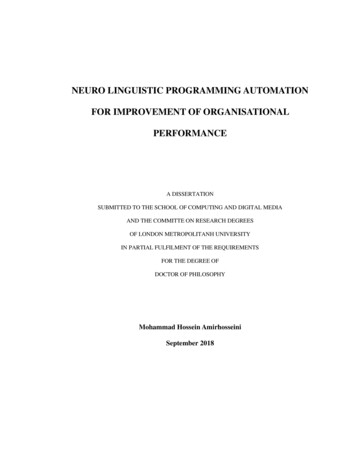
Transcription
NEURO LINGUISTIC PROGRAMMING AUTOMATIONFOR IMPROVEMENT OF ORGANISATIONALPERFORMANCEA DISSERTATIONSUBMITTED TO THE SCHOOL OF COMPUTING AND DIGITAL MEDIAAND THE COMMITTE ON RESEARCH DEGREESOF LONDON METROPOLITANH UNIVERSITYIN PARTIAL FULFILMENT OF THE REQUIREMENTSFOR THE DEGREE OFDOCTOR OF PHILOSOPHYMohammad Hossein AmirhosseiniSeptember 2018
Copyright by Mohammad Hossein Amirhosseini 2018All Rights Reserved
AbstractNeuro Linguistic Programming (NLP) is a methodology used for recognition ofhuman behavioural patterns and the modification of the behaviour. A significant part ofthis process is influenced by the theory of representational systems which based on thefive main senses. Meta model is another important technique in this process. Thistechnique can be adopted to allow an individual to gain a better understanding of theirown issues as well as those of others. Another vital factor in NLP are Meta programs,which are habitual ways of inputting sorting and filtering the information found in theworld around us. The difference in Meta programs results in significant differences inbehaviour from one person to another, the type of personality can be recognised throughutilising and analysing the Meta programs. There are different methods to predict thepersonality type based on Meta programs and Myers-Briggs Type Indicator (MBTI) iscurrently considered to be one of the most popular and reliable methods. Traditionally, theapplication of NLP relies on consultation with a profession qualified in implementationof this technique. To circumvent the limitations in reliability of this process, attempts ofautomation of this technique have been carried out. These attempts aim to eliminate theeffect of human error such as lack of skill and experience, inconsistency in judgement,inaccuracy or mistakes as well as the impact of personal opinion. Nonetheless, manyshortcomings are integral of the methodologies adopted in these attempts. Primarily, theseautomations are in the format of computerisation of the NLP practice and no artificialintelligence techniques have been implemented to substitute the role of the humanpractitioner. Hence, improvement of reliability and accuracy remain a challenge forapplication of NLP, which this research aims to address using artificial intelligence
techniques such as natural language processing. The second challenge in this field is theopportunity of applying NLP to benefit a group of people in order to make NLP applicablefor organisations rather than individuals alone. This research aims to create this prospectin order to extend the application of NLP for improvement of organisational performance.The focus of this research is on the automation of the three main branches of NLP,which includes (1) identification of the preferred representational system, (2) the Metamodel and (3) personality type prediction based on the Meta programs. Hence, it aims togenerate an intelligent software for recognising the preferred representational system andpersonality type of employees as individuals and also as a group. This recognition offersorganisations a specific output of information and relevant advice to improve taskallocation, communication and teamwork. Moreover, this research also aims tosignificantly increase the efficiency, accuracy and reliability of using NLP by substitutingthe dependence on human judgement by an automated software. Limitations of previouscomputerisations of NLP are also aimed to be responded to by incorporation of artificialintelligence. To achieve these objectives, the means of analysing the behavioural patternof individuals by software is to be explored. Moreover, the implementation of naturallanguage processing for identifying the preferred representational system, personalitytype and application of the NLP Meta model during a human-computer conversation willbe investigated.To examine the function of the software and the reliability of its output, threeevaluations are to be conducted. Firstly, the results of using the software is to be comparedto the use of a questionnaire, which the responses to would be analysed by an experiencedNLP practitioner. Both of these methods are to focus on the identification of the preferred
representational system. Secondly, the application of the Meta model in a humancomputer conversation is to be compared to an NLP practitioner’s analysis of the sameconversation. Thirdly, the analysis of personality type is to be evaluated by comparing theuse of the intelligent software to the use of a computerised questionnaire.Natural Language Processing and machine learning techniques were used for theautomation process and an intelligent software has been developed. The automation issuccessful in eliminating human errors, thereby the software is able to perform with ahigher level accuracy, reliability and efficiency. The performance of the software has beentested and compared to the performance of humans and existing methods. Regarding therepresentational system identification, the results of the software are similar to anexperienced NLP practitioner. However, in various parts of the process, the softwareresponded more accurately than a human practitioner. The results of the automated Metamodel have shown increased accuracy in identification of the language patterns used inconversation. The recovery of information has shown to be more efficient in the softwarein comparison to an NLP practitioner. Finally, the results of the software regarding thepersonality type prediction was highly accurate and reliable after comparing with anofficial MBTI questionnaire. The novel methodology created in this research will assistthe NLP practitioners and psychologists to obtain an improved understanding of theirclients’ behavioural patterns and the associated cognitive and emotional processes. It canalso facilitate the organisational performance improvement in organisations.
AcknowledgmentsThe words ‘thank you’ are not a strong enough statement of my gratitude. Thework on this thesis has been an inspiring, often exciting, sometimes challenging, butalways a thought-provoking and intriguing experience. It has been made possible by themany people who have supported me.I wish to express my sincere gratitude to my Ph.D. supervisors. Thank you to mylead supervisor, Professor Hassan Kazemian for his guidance and support of my work.His passion for high quality research, dedication to work closely with his students,enthusiasm to challenge new research fields and methods and his kindness are thereasons he is an inspiration to me and to all of his students. I also wish to thank mysecond supervisor, Professor Karim Ouazzane, and my third supervisor, Doctor ChrisChandler for their support.Thank you to all of my family and friends for their unwavering support andencouragement. I am especially thankful and appreciative of my parents, DoctorKhatereh Azimi and Doctor Hamid Amirhosseini, for their emotional and financialsupport as well as their continuous encouragement throughout this Ph.D. and my time ineducation. Thank you also to my brother and sister for their endless support andencouragement. Their happiness and their success in education has always motivated meto push and challenge myself further. A special thank you to my wife, FatemehKalabizadeh. I wish to express my deepest gratitude for her constant support,understanding and love. Thank you also to her family for their kindness and unendingencouragement during this Ph.D.
PublicationAmirhosseini, M.H., Kazemian, H., Ouazanne, K. and Chandler, C. (2018) 'NaturalLanguage Processing approach to NLP Meta model automation', IEEE World Congresson Computational Intelligence: Proceedings of the International Joint Conference onNeural Networks, Rio de Janeiro 8-13 July, pp.186-193.Amirhosseini, M.H. and Kazemian, H. (2019) ‘Automating the process of identifying thepreferred representational system in Neuro Linguistic Programming using NaturalLanguage Processing’, Cognitive Processing Journal, Springer. doi: 10.1007/s10339019-00912-3
Table of Contents1. Introduction .11.1 Aim and objectives .11.2 Research questions .21.3 Introduction to Neuro Linguistic Programming .31.4 History and development of Neuro Linguistic Programming .41.5 NLP and organisational performance .61.6 Background of NLP automation .81.7 Research challenges .191.8 Contribution of this thesis to the knowledge .201.9 Overview of the thesis .222. Background and literature review .242.1 Introduction .242.2 Definition of Neuro Linguistic Programming .242.3 Representational systems.272.4 Meta model .312.5 Meta programs .362.5.1Basic Meta programs .382.6 Personality types .41
2.6.1Related methodologies for personality type prediction .532.6.2Logistic Regression .562.6.3 Naïve Baysian .572.6.4 Random Forest .592.6.5 K Nearest Neighbor (KNN) .602.6.6 Linear Discriminant Analysis (LDA) .602.6.7 Support Vector Machine (SVM) .612.6.8 Extreme Gradient Boosting .622.7 Summary.633. Neuro Linguistic Programming Automation methodology .643.1 Introduction .643.2 Automating the preferred representational system identification .643.2.1Natural Language Processing as a tool for automation .643.2.2 Software structure and development procedure .663.2.3 Tokenization process .703.2.4 Lexical and Syntactic analysis .703.2.5 Comparison process .733.3 Automating the process of using the Meta model .773.3.1 Software structure .773.3.2 Programming language and the relevant library.77
3.3.3 Asking a question .783.3.4 Defining the key words.813.3.5 Tokenization process .833.3.6 Lexical and Syntactic analysis .833.3.7 Comparison process .843.3.8 Decision making process .853.3.9 Informing the person.863.3.10 Repetition process.873.4 Automating the process of personality type prediction .893.4.1 Related methodologies for personality type prediction .893.4.2 Dataset for training the model .903.4.3 Proportionality in dataset .903.4.4 Categorizing the type indicators in four dimensions .953.4.5 Pre-processing the dataset.983.4.6 Vectorise with count and Term Frequency-Inverse Document Frequency (TFIDF) .983.4.7 Classification task .993.4.8 Developing Gradient Boosting model for the dataset .993.4.9 Employees’ MBTI personality type prediction .1063.4.10 Multiple choice questionnaire.106
3.4.11 Designing questions .1073.4.12 Comparison process for predicted personality types .1093.4.13 File processing procedure for predicted personality types .1093.5 Participants and data gathering procedure . 1103.6 Data analysis procedure . 1143.7 Demonstration of the software . 1143.8 Summary.1224. Results and Discussion.1244.1 Introduction .1244.2 Results of automated representational system identification .1244.3 Results of automated Meta model system .1394.4 Results of automated personality type prediction .1484.5 Results of using representational system identifier in the company .1574.6 Results of using Meta model system in the company .1594.7 Summary.1635. Conclusion .1655.1 Conclusion of the research .1655.2 Recommendations and future work .169References .171Appendix 1 – The preferred representational system questionnaire .185
Appendix 2 - MBTI personality type questionnaire .189
List of Tables2.1Color coding system for describing cognitive functions of each MBTI personalitytype .442.2Description of personality types .442.3Top five careers for each personality type .462.4Career matches by personality type .472.5Researches on personality type prediction and personality model used .553.1Example of visual representational system predicates .743.2Example of auditory representational system predicates .743.3Example of kinaesthetic representational system predicates .753.4Example of auditory digital representational system predicates .753.5Specific key words to be used in different steps of the Meta model .823.6The breakdown of the total number of people of each type in the dataset .923.7Percentage of occurrence of each MBTI personality type in the dataset .933.8Personality type distribution in the general population .943.9Distribution across type indicators .953.10Correlation efficient between personality type indicators .973.11Accuracy of MBTI personality type prediction by software .1003.12Prediction accuracy for each MBTI binary class .101
3.13Comparison of prediction before and after configuration .1023.14Comparison of accuracy of post classification and user classification methods forrecurrent neural network .1043.15Comparison of accuracy Extreme Gradient Boosting model and recurrent neuralnetwork model .1054.1Difference between questionnaire and automated representational systemidentifier results .1284.2Recognised predicates by human .1304.3Recognised predicates by software .1324.4Comparing the human and software performance .1334.5Comparing the performance of the software and human .1434.6Comparing the number of recovery questions related to each deletion categoryasked by the software and human .1454.7Comparing the number of recovery questions related to each distortion categoryasked by the software and human .1464.8Comparing the number of recovery questions related to each generalizationcategory asked by the software and human.1474.9Personality type frequency in organisation based on Gradient Boosting modelresults .154
List of Figures1.1VAK test .81.2VAK test result .91.3A sample of using Manteya in outlook . 111.4Manteya result .121.5Manteya result .131.6LifeSet questionnaire .141.7LifeSet questionnaire .152.1NLP elements .262.2Representational systems .272.3Reception, perception and comprehension processes .322.4The Meta model mechanism .332.5Personality types key .412.6Personality types in Myers-Briggs Type Indicator .422.7The cognitive functions of each personality type .433.1Development procedure of the first phase of implementation .693.2Development procedure of the second phase of implementation .883.3Number of occurrence for each MBTI personality type in the dataset .913.4Percentage of occurrence for each MBTI personality type in the dataset .92
3.5Distribution across type indicators .963.6Pearson correlation coefficient between personality type indicators .973.7Scoring strategy for the computerised MBTI questionnaire .1083.8Answer sheet for the preferred representational system questionnaire . 1123.9Software beginning the conversation . 1153.10Software detecting generalisation . 1163.11Scoring strategy for the computerised MBTI questionnaire . 1183.12Scoring strategy for the computerised MBTI questionnaire .1213.13Scoring strategy for the computerised MBTI questionnaire .1214.1Questionnaire results for the preferred representational system of participants.1254.2Software results for the preferred representational system of participants .1264.3Comparing the number of preferred representational systems identified by aquestionnaire and software.1274.4Number of predicates related to each representational system identified by human.1304.5Number of predicates related to each representational system identified bysoftware .1314.6Comparing the number of predicates identified by human and software .1324.7Comparing the number of visual predicates, identified by the human and software
.1344.8Comparing the number of auditory predicates, identified by the human andsoftware .1354.9Comparing the number of kinaesthetic predicates, identified by the human andsoftware .1364.10Comparing the number of auditory digital predicates, identified by the human andsoftware .1374.11Number of recovery questions about deletion, distortion and generalization, askedby the software .1414.12Number of recovery questions about deletion, distortion and generalization, askedby human .1414.13Comparing the number of Deletion, Distortion and Generalization, identified bythe human and software .1424.14Comparing the number of recovery questions related to each category of deletion,distortion and generalization processes, asked by the software and human .1444.15 Number of personality type in the organisation based on the questionnaire results.1494.16 Number of personality type in the organisation based on the software results .1504.17 Comparing the number of identified personality types via questionnaire andsoftware .151
4.18 Frequency of each personality type in the company identified by the software. 1524.19Frequency of each personality type in the company identified by the software.1534.20 Most popular personality type in the company based on the system results. .1554.21 Most popular personality type in the company based on the questionnaire results.1564.22Number of employees in each category of preferred representational system .1584.23percentage of each preferred representational system in the company. .1584.24percentage of each category of recovery questions asked b the software. .1604.25number of recovery questions related to each category of the deletion, distortionand generalization. .1614.26Percentage of recovery questions related to each process of the deletion, distortionand generalization. .162
cProgramming, which is a psychologicalapproach for personality development.Natural Language ProcessingA subfield of artificial intelligence andlinguistic, which aims to enable computersto understand the words or sentences writtenin human languages.Representational systemDifferent ways that people represent or storeinformation in their mindPredicateSensory words in language, which canreveal the use of the related sensorymodality to give an indication of anindividual’s preferred system of use.VisualSensory channel for coding and storinginformation in mind through seeingAuditorySensory channel for coding and storinginformation in mind through hearingKinestheticSensory channel for coding and storinginformation in mind through feelingOlfactorySensory channel for coding and storinginformation in mind through smellingGustatorySensory channel for coding and storinginformation in mind through tastingAuditory DigitalA non-sensory system referring to howpeople sort experience following itsoccurrence focusing on self-talk, discrete
words, facts, figures and logic.Meta ModelA method for identification of languagepatterns to detect generalisation, distortionand deletion of information in speech withthe aid of specific questions to recover theinformation not presented throughlanguage.DeletionProcess of deleting portions of thepresented conceptDistortionProcess of distorting portions of thepresented conceptGeneralisationProcess of generalising portions of thepresented conceptMeta programmeCognitive strategies and habitual ways ofinputting information, sorting them andfiltering the world around us.MBTIAn assessm
Neuro Linguistic Programming (NLP) is a methodologyused for recognition of human behavioural patterns and the dification of the behavioumo A significant part of r. this process is influenced by the theory of representational systems which the based on five main senses. Meta m

